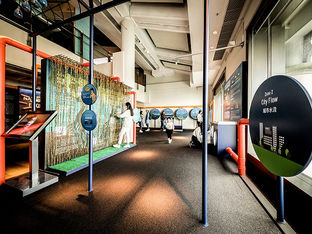
Jockey Club Water Caretakers of Tomorrow



Organisers:
Jockey Club Water Caretakers of Tomorrow is a collaboration which has been funded by the Hong Kong Jockey Club Charities Trust and developed by Ocean Recovery Alliance, Ltd., a Hong Kong registered charitable organization.
Jockey Club Water Caretakers of Tomorrow -- What is it?
Jockey Club Water Caretakers of Tomorrow is an educational curriculum project designed for 11-13 year old students* in Hong Kong schools. Through a combination of inquiry-based and project-based learning, students develop understanding and appreciation for our water systems and functions, at both the local and global levels. They learn how to assess threats such as pollution and habitat destruction, and also develop ways to mitigate them. This understanding will empower them to take an active role as caretakers of our water resources of the future, and to share their commitment with their families and communities.
Project Description
This project provides early secondary schools with free curriculum materials focused on water systems, from mountains to the sea, for distribution to Hong Kong English language and international schools. This innovative program utilises best teaching practices, including inquiry-based and hands-on learning. The curriculum is comprised of eight units, each of which can be adopted singly or collectively, depending upon the needs of the school and the classroom. The curriculum materials utilise examples from the local environment to foster contextual understanding of water resources, and to promote stewardship and opportunities to protect them. Every unit, except the introductory unit, contains suggested action pieces that build on the students’ understanding of the issues in that unit.
*Form 1-3, Early Secondary and Middle School Grades 6-8
Hong Kong Maritime Museum Display
"Water in the Balance," is an exciting and ongoing connectivity between our new curriculum, the "Jockey Club Water Caretakers of Tomorrow," and the public, is now open as an exhibit at the Hong Kong Maritime Museum at Pier 8 in Central, Hong Kong. Come see the journey of "Water Jai," the water droplet which travels from the mountains to the sea. The educational exhibit for all ages highlights Hong Kong’s unique local water resources while establishing our own connection to global water resources. The exhibit will also showcase some of the activities carried out by schools that have adopted the curriculum, along with project displays.


Goals and Objectives
Students who have been exposed to the curriculum will:
Understand and appreciate how our water systems function on a local and global scale
Understand how watersheds function, and the interconnections of life within and between these watersheds
Be able to assess threats, such as pollution and habitat destruction, and learn how to mitigate these effects
Be empowered to take an active role as caretakers of our water resources by sharing their commitment with their communities
Benefits to Schools and Teachers
Free teacher training sessions for curriculum delivery
Curriculum designed by educators, for educators, means that all of the content is teacher- and student-friendly
Suggested activities are included for both in-class learning, and outdoor experiential education
Extensions for enrichment and cross-curricular links in every unit Publicity about student action through the Maritime Museum exhibit
Unit 1: Miraculous Water
Introductory unit
Physical and chemical properties of water
Role of water in the environment
Water cycle
Student Notes in PDF and Word: Student Notes (PDF) Student Notes (Word)
Additional Resources (1), Additional Resources (2)
Unit 2: It’s All Downhill
Delineate watersheds
Understand links and interactions in a watershed
Connect land use with impacts to a watershed
Student Notes in PDF and Word: Student Notes (PDF) Student Notes (Word)
Unit 3: Stressed-out Watershed
Track sources and effects of pollution in a watershed
Understand how to balance uses in a watershed
Appreciate changes in attitude about watershed modification
Student Notes in PDF and Word: Student Notes (PDF) Student Notes (Word)
Unit 4: Water as Source -- Lifeblood of an Ecosystem
Describe freshwater ecosystems and the factors that affect them
Compare differences in natural and polluted ecosystems
Conduct field studies
Understand conservation and management strategies
Student Notes in PDF and Word: Student Notes (PDF) Student
Notes (Word)
Additional Resources (1), Additional Resources (2)
Unit 5: Water as Resource
Identify the sources of clean water on Earth
Understand how to manage and conserve for multiple uses of a limited renewable resource
Anticipate consequences of changes to water supply
Student Notes in PDF and Word: Student Notes (PDF) Student Notes (Word)
Unit 6: Down the Drain
Understand sewage and drainage systems
Identify ways to reduce water pollution associated with drainage
Gather data about stormwater pollution
Student Notes in PDF and Word: Student Notes (PDF) Student Notes (Word)
Unit 7: For Shore -- Looking After Coasts and Estuaries
Connect uses upstream with the effects downstream on the coast
Understand the multiple functions of coastal habitats
Balance competing coastal uses
Student Notes in PDF and Word: Student Notes (PDF) Student Notes (Word)
Additional Resources (1), Additional Resources (2), Additional Resources (3)
Unit 8: The Blues: Can We Save the Ocean?
Investigate basic ocean ecosystems and organisms
Understand the connection between the ocean and the land
Appreciate consequences of ocean management and exploitation
Explore the effects of ocean pollution
Student Notes in PDF and Word: Student Notes (PDF), Student Notes (Word)






